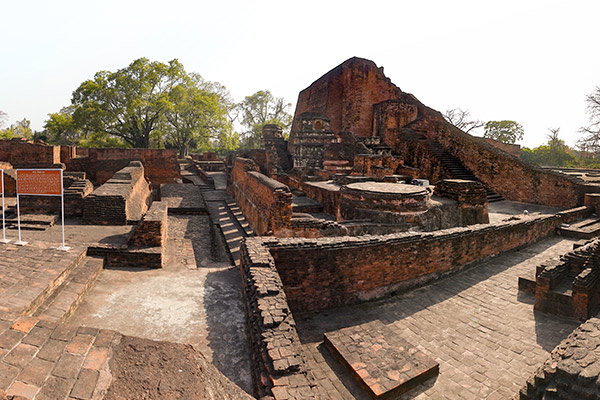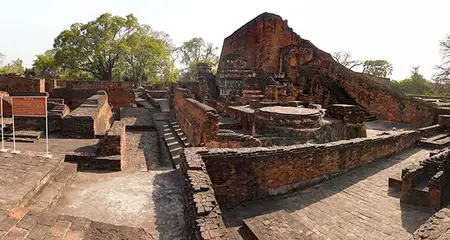Nalanda near Patna is where you can find the archaeological remains of a Mahavihara or Buddhist monastery, which was one of the earliest and finest universities in India. In ancient days, this monastic and scholastic institution was located in the kingdom of Magadha, which is now the modern state of Bihar. Nalanda University Archaeological Complex is currently located about 84 km away from Patna, the capital city of Bihar. A visit to the complex makes for an enriching journey into history, architecture, culture, and Buddhism. If you are a history buff, make sure to include this ancient university in your itinerary when planning a trip to and booking your hotels in Patna.
Looking for more details about the ancient seat of learning? This blog tells you everything you should know about Nalanda University, including its history, timings, entry fee, and other interesting details.
Nalanda University Information:
| Location | Nalanda district |
| Timings | 9:00 am to 5:00 pm; every day |
| Entry Fee | ₹ 15 for Indians and SAARC and BIMSTEC citizens; ₹ 200 for foreigners; free entry for children below 15 years of age |
| Video Camera | ₹ 25 |
| Distance from Patna | 84 km |
| Year of Establishment | 5th century |
| Year of Abandonment | 12th century |
| Type | Archaeological complex |
| Status | UNESCO World Heritage Site |
| Area | 30 acres |
Nalanda Mahavihara: History
The origins of the scholastic institution in Nalanda date back to the 5th century CE and it served as a highly recognized seat of learning for an uninterrupted duration of 800 years. The university thrived under the patronage of the rulers of the Gupta dynasty during the 5th and 6th centuries. It continued to flourish under Emperor Harshavardhan of Kannauj in the 7th century as well. The growth and the popularity of the university continued until the 9th century, after which its gradual decline started.
This decline was primarily due to the establishment of four other seats of Buddhist learning in the same region under the Pala Empire from the 9th century to the 12th century. Historians assume that this great center of learning was ransacked and destroyed in the 12th century by Bakhtiyar Khilji of the Delhi Sultanate, which led to the total decline and abandonment of the institution.
At its peak, the institution attracted students and scholars from far off places like Korea, China, Tibet, and Central Asia as well. It was home to more than 2,000 teachers and 10,000 students. History has it that Mahavira and Buddha visited Nalanda in the 5th and 6th centuries. Renowned Chinese scholar Hsuan-Tsang also visited the institution in the 7th century to learn the Vedas, Buddhist theology, and metaphysics.
After its decline, Nalanda remained forgotten until the 19th century when the Archaeological Survey of India started conducting excavations on the site. These excavations have led to the discovery of many ruins but the excavated area comprises of just a minor portion of the whole institution of Nalanda.
Nalanda University Architecture
Nalanda was regarded as an architectural masterpiece. Enveloped by a lofty wall and a huge gate, the institution comprised of several temples, viharas (educational and residential buildings), compounds, stupas, classrooms and meditation halls. Parks and lakes also adorned the institution’s grounds. The excavated ruins of the institution indicate that bright red bricks were used in its construction.
One of the highlights of Nalanda was its well-equipped and colossal library housed in three large multi-storied buildings called the Ratnasagara (Ocean of Jewels), the Ratnaranjaka (Jewel-adorned), and the Ratnodadhi (Sea of Jewels). Ratnodadhi was where the most sacred manuscripts of the institution were kept and this building was nine stories high.
Nalanda Mahavihara: Today
Nalanda flourished on a sprawling campus in the medieval times, but only a small portion of that huge campus has been excavated till date. Today, nothing more than the ruins of the Nalanda Mahavihara remain on the site. However, due to its historical, educational, and religious significance, the ruins of Nalanda are considered among the top historical places in and around Patna. It is also a top tourist attraction in India and an important site for those exploring the Buddhist tourism circuit.
The ruins of Nalanda have also been declared a UNESCO World Heritage Site in India in 2016. Nalanda University Archaeological Complex is currently owned, maintained, and protected by the Archaeological Survey of India. The 30-acre excavation area also comprises a museum, temples, and ruins of other structures.
Nalanda Museum
Since 1917, the Nalanda Mahavihara Site houses the Nalanda Archaeological Museum where several the excavated artifacts have been kept on display. These include coins, sculptures, images of Buddha, inscriptions, seals, samples of burnt rice, terracotta jars, and other antique items. A visit to the museum will give you an idea about the items that were in use when the Nalanda Mahavihara was at its peak.
- Museum Timings: 10:00 am to 5:00 pm; closed on Fridays
- Museum Entry Fee: ₹ 5 per head; free for children up to 15 years of age
Things to See in the Nalanda Complex
Though much of the Nalanda Mahavihara is yet to be excavated, there is a lot to see in the excavated area that spreads across 30 acres. This includes the following:
- Ruins of the Nalanda University
- Ruins of monasteries
- Ruins of brick temples
- Stupa of Sariputta
- Sarai Temple
- Nalanda Archaeological Museum
- Nalanda Multimedia Museum (privately run)
- Xuan Zang Memorial
- Surya Mandir
- Black Buddha Temple
- Nalanda Vipasana Centre
Lesser Known Facts Nalanda University
- The massive library of Nalanda was called Dharma Gunj, meaning the Treasury of Truth or the Mountain of Truth. It contained hundreds of thousands of books.
- It is believed that the library of Nalanda was so huge that it burned for months after the university was ransacked by Bakhtiyar Khilji and the library was set on fire.
- Nalanda was attacked three times by the invaders – the Huns, the Gaudas, and finally Bhaktiyar Khilji who brought about its complete destruction.
- Archeologists and historians are of the opinion that just 10% of the Nalanda campus has been excavated till date. Around 90% remain to be excavated.
- The ruins of Nalanda were the location for the shooting of the popular song “O Mere Raja” from the Bollywood movie Johny Mera Naam starring Hema Malini and Dev Anand.
Attractions near Nalanda Mahavihara
- Kundalpur (4 km)
- Bihar Sharif (14.2 km)
- Pawpuri (14 km)
Nalanda, beyond any doubt, was an amazing world in itself where education and Buddhism flourished and reached great heights. You will need to use your imagination to visualize how these mere ruins were once a renowned learning center for thousands of students. Up for the challenge? Plan a trip to Nalanda University Archaeological Complex and spend a few hours walking through the remains of India’s first international university.


























